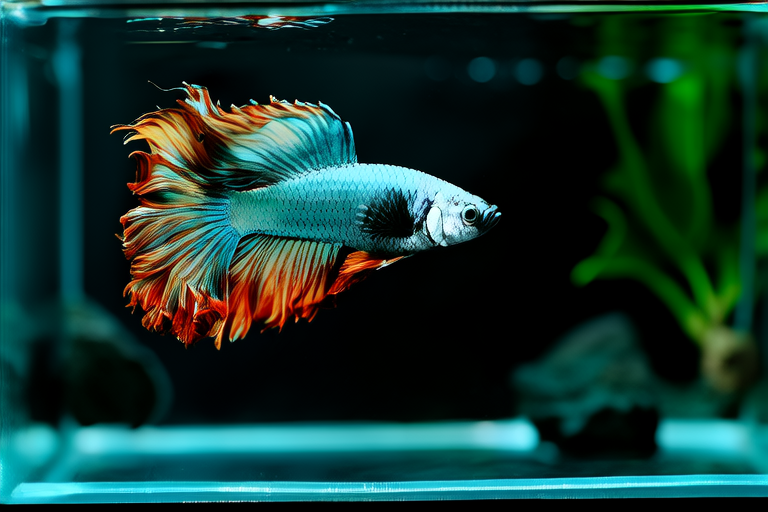
Betta Bliss: Expert Tips on Choosing the Perfect Companion Plants
Creating the perfect habitat for your betta fish involves more than just providing clean water and a spacious tank. The addition of companion plants not only enhances the aesthetic appeal but also offers significant benefits to the overall health of your aquatic environment. This article will guide you through the process of selecting the right plants for your betta’s tank, discuss the importance of water parameters, lighting needs, and provide养护 tips for both plants and fish to ensure a healthy ecosystem.
The Importance of Companion Plants
Companion plants play a crucial role in maintaining a balanced and healthy aquarium ecosystem. They provide hiding spots, reduce stress, and offer natural enrichment for your betta fish. Additionally, they help maintain water quality by absorbing nutrients and waste products, which can otherwise lead to harmful algae growth and poor water conditions.
Water Parameters
Understanding the specific water parameters required for your betta fish is essential before introducing any plants. Bettas prefer slightly acidic water with a pH between 6.8 and 7.2 and a temperature range of 76°F to 82°F (24°C to 28°C). Ensure that the plants you choose thrive within these parameters to avoid stressing your fish.
Lighting Needs
Proper lighting is vital for the photosynthesis process in plants, which in turn supports their growth and health. Choose a light source that provides at least 8 to 10 hours of light per day. LED lights are a popular choice due to their energy efficiency and adjustable color temperatures. However, be cautious not to overexpose your fish to light, as excessive illumination can cause stress.
Recommended Companion Plants
Anubias Barteri
Anubias barteri is a robust and slow-growing plant that thrives in low-light conditions. Its broad leaves provide excellent hiding spots for your betta fish. To care for Anubias barteri, attach it to driftwood or rocks using fishing line or plant weights. Avoid burying its rhizome, as this can lead to rot.
Cryptocoryne Wendtii
Cryptocoryne wendtii is another great option for betta tanks. It grows well in low to medium light and prefers slightly acidic water. Ensure that the water temperature remains stable to prevent “crypt melt,” a condition where the plant’s leaves disintegrate.
Java Fern (Microsorum Pteropus)
Java Fern (Microsorum pteropus) is one of the most popular choices for betta tanks due to its hardiness and ease of care. It requires minimal lighting and can be attached to driftwood or rocks. Be cautious when pruning Java Fern, as it may take time to recover.
Aesthetic Appeal
In addition to their functional benefits, companion plants significantly enhance the visual appeal of your aquarium. Consider the color, shape, and size of the plants to create a harmonious and visually pleasing arrangement. For instance, combining broad-leaved plants like Anubias barteri with fine-leaved plants such as Cryptocoryne wendtii can add depth and interest to your tank.
养护 Tips for Plants and Fish
Plants
- Ensure regular water changes to maintain optimal water quality.
- Prune dead or yellowing leaves promptly to encourage new growth.
- Monitor the growth rate of your plants and trim them as necessary to prevent overcrowding.
- Use fertilizers sparingly, as excess nutrients can lead to algae blooms.
Fish
- Feed your betta fish a balanced diet rich in protein and vitamins.
- Observe your fish daily for signs of illness or stress, such as lethargy, loss of appetite, or abnormal behavior.
- Provide hiding spots and areas for swimming to reduce stress.
- Perform regular water tests to monitor pH, ammonia, nitrite, and nitrate levels.
Common Mistakes to Avoid
When selecting companion plants for your betta tank, it’s important to avoid certain pitfalls:
- Choosing fast-growing plants that can quickly overrun the tank.
- Selecting plants that require high lighting or specific water conditions that may not be suitable for your betta fish.
- Overcrowding the tank with too many plants, leaving insufficient space for your fish to swim.
- Introducing plants that can produce harmful substances, such as those containing phenols or tannins.
Maintaining a Vibrant and Thriving Aquatic Environment
To maintain a vibrant and thriving aquatic environment for your betta fish and their companion plants, follow these guidelines:
- Regularly monitor and adjust water parameters to ensure they remain within the ideal range for both your fish and plants.
- Perform weekly water changes to remove waste and replenish essential minerals.
- Trim and prune plants as needed to promote healthy growth and prevent overcrowding.
- Consider adding beneficial bacteria to your tank to aid in the breakdown of waste products and maintain a stable nitrogen cycle.
- Provide adequate hiding spots and enrichment opportunities for your betta fish to reduce stress and promote natural behaviors.
By carefully selecting the right companion plants and following proper养护 practices, you can create a beautiful and healthy aquatic environment for your betta fish. With the right combination of plants and care, your tank will become a thriving ecosystem that brings joy and relaxation to both you and your fish.






